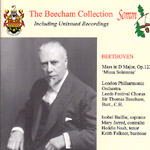This performance, captured live on October 5, 1937 in Leeds Town Hall, is the only document of Thomas Beecham conducting Beethoven’s monumental Missa solemnis, and as such it has been highly prized by collectors. Apparently, the only mastering source available was a set of rather worn 78s, and although they’re mostly free of surface noise, they do suffer from distortion, particularly in the Kyrie where the timpani over-saturate and the soloists sound off pitch. But the real question is, can such a forceful and explosive work as the Missa solemnis be fully experienced in such dim, dynamically limited sound?
Luckily, Beecham’s finely shaped and sculpted reading is set on a grand scale (at least it seems to be, judging from the distortion in the tutti passages). The conductor takes the Gloria at a breathless pace, but his Credo is slower than today’s norm as represented by Bernstein, Shaw, and Solti. The Sanctus’ finely graded introduction is somewhat spoiled by a lumbering Pleni sunt coeli, but Beecham pulls out the stops in his powerful rendering of the closing Dona nobis pacem.
Of the soloists, tenor Heddle Nash makes the best impression, and baritone Keith Falkner makes the worst, with weak low notes, bad intonation, and miserable diction (“miz-ah-rrrre-ray”). Isobel Baillie’s soprano floats sweetly, while contralto Mary Jarred has that hooty quality common to a certain era of British solo singing. To be sure, this is not going to be anybody’s choice Missa solemnis, because even though Beecham’s full-bodied, massive conception must have been quite thrilling in the concert hall, you’ll definitely need to have vivid memories of the piece to fill in the gaps (like much of the woodwind detail). Still, committed Beecham fans may find some justifiable delights.
































